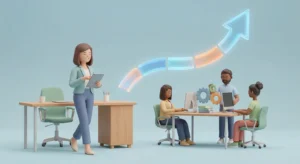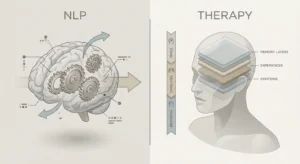Limiting beliefs are the hidden mental barriers that quietly influence your decisions, relationships, and success. They’re deeply rooted thoughts formed by past experiences, upbringing, or repeated fears. While they often operate subconsciously, their effects are visible from procrastination and self-doubt to fear of failure or rejection.
By learning to recognize emotional triggers, negative self-talk, and recurring life patterns, you can uncover and replace these beliefs. NLP (Neuro-Linguistic Programming) provides powerful tools such as reframing, anchoring, and timeline therapy to help you rewire old thinking patterns and build a mindset that supports your goals.
Have you ever wondered why you sometimes hold yourself back, even when opportunities are right in front of you? That hesitation often isn’t about lack of skill or motivation; it’s about what you believe deep down
.
Limiting beliefs are the quiet, internal statements like “I’m not good enough” or “I always mess things up.” They shape how you interpret the world, influencing everything from confidence to career decisions. The tricky part? Most of these beliefs run on autopilot.
The first step to freedom is awareness, learning to see the invisible rules you’ve been living by and consciously rewriting them.
Key Takeaways
- Limiting beliefs are subconscious barriers that shape how you think and act.
- NLP tools like reframing, anchoring, and timeline therapy help replace them.
- Belief transformation takes awareness, consistency, and aligned emotion.
- Once beliefs shift, action becomes natural and success feels effortless.
- Emotional triggers, self-talk, and recurring life patterns help reveal them.
Understanding Limiting Beliefs

Limiting beliefs are deeply ingrained thoughts that restrict what you think is possible. They’re not just negative thoughts; they’re mental programs that define your reality.
For example:
- “I don’t deserve success.”
- “People like me can’t change.”
- “I’m too old to start over.”
These beliefs often form early in life from parental influence, cultural conditioning, or emotional experiences that shaped your sense of worth. Over time, they become mental shortcuts your brain uses to “protect” you from failure or rejection, even when they no longer serve you.
Recognizing them doesn’t mean judging yourself; it means seeing where your mindset came from so you can choose differently.
Common Signs You Have Limiting Beliefs
Limiting beliefs aren’t always obvious. They reveal themselves through patterns of thought, emotion, and behavior. Here are a few key signs:

- Persistent self-doubt: You question your abilities even after success.
- Fear of failure or rejection: You avoid challenges because you fear embarrassment or disapproval.
- Procrastination: You delay action because you subconsciously expect to fail.
- Overthinking and self-criticism: You replay mistakes or assume others are judging you.
- Emotional tension around growth: Even thinking about change brings anxiety or guilt.
If these feel familiar, you’re likely bumping up against an internal belief that says, “It’s safer not to try.”
How to Identify Limiting Beliefs

Becoming aware of limiting beliefs is like turning on the lights in a dark room. Once you see them, you can’t unsee them. Try these practical methods:
Notice Emotional Triggers
Pay attention to when you feel frustration, shame, or fear. Emotional reactions often point to hidden beliefs. For example, if praise makes you uncomfortable, a belief like “I don’t deserve recognition” might be running underneath.
Examine Repeated Life Patterns
Notice recurring challenges, similar job frustrations, relationship issues, or financial blocks. Repetition often signals a belief that keeps creating the same outcome.
Listen to Your Self-Talk
Your internal dialogue reveals your subconscious programming. If you catch yourself saying, “I’m just not that type of person,” or “I always fail at this,” write it down; that’s a belief waiting to be rewritten.
Reflect on Early Influences
Many limiting beliefs are inherited. Think about phrases you heard growing up, like “money doesn’t grow on trees” or “you have to struggle to succeed.” These shape your worldview until you consciously challenge them.
NLP Techniques to Uncover Limiting Beliefs
NLP (Neuro-Linguistic Programming) provides effective methods for identifying and transforming mental blocks at the subconscious level.
Reframing
Reframing helps you shift how you interpret events. Instead of seeing failure as proof of inadequacy, NLP teaches you to view it as feedback, a chance to refine your approach.
Timeline Therapy
This technique helps trace emotional patterns back to their roots. By revisiting the original experience where a limiting belief formed, you can release its emotional charge and replace it with a new, empowering perspective.
Anchoring
Anchoring uses physical or mental cues like pressing two fingers together or saying a keyword to trigger positive emotions. It helps you access confidence or calm when old beliefs surface.
Visualization
NLP visualization goes beyond imagination; it uses all senses to create vivid mental experiences. By repeatedly visualizing success with emotion and sensory detail, you train your subconscious to accept it as truth.
Transforming Limiting Beliefs into Empowering Ones

Once you identify a limiting belief, the next step is to transform it. Start by writing it down, then ask:
- Is this belief absolutely true?
- Where did it come from?
- How has it helped or limited me?
Replace it with a statement that feels both believable and empowering.
For example:
- “I can’t handle pressure.” → “I perform calmly under pressure.
- “I’m not smart enough.” → “I’m learning and improving every day.”
Consistency is key. Repeat your new belief daily, especially when old patterns arise. Pair it with visualization, imagine yourself acting confidently, making decisions, and feeling at ease. Over time, your subconscious will align with the new narrative.
Practical Steps for Ongoing Awareness
Transforming beliefs is not a one-time task; it’s a practice.
Here are small, consistent habits to stay aligned:
- Keep a belief journal: Write down negative thoughts and reframe them immediately.
- Use mindfulness techniques: Notice your emotions without judgment. Awareness breaks automatic reactions.
- Surround yourself with growth-minded people: Environment reinforces belief systems.
- Practice gratitude: It shifts focus from limitation to abundance, retraining the mind toward positivity.
- Seek NLP coaching or therapy: A skilled practitioner can help uncover deeper patterns you might overlook.
Conclusion: Your Mind as the Foundation of Change
Every limitation begins as a thought and every transformation starts with awareness.
When you identify and rewrite the beliefs that hold you back, you change more than your mindset; you change your possibilities.
NLP gives you the tools to do that to align your thoughts, emotions, and identity with who you truly want to be. The moment you question your old story, you create space for a new one to begin.
FAQs
1. How do I know if I have limiting beliefs?
If you feel stuck, unworthy, or afraid of failure even when opportunities are available, hidden beliefs may be influencing your actions.
2. Can NLP really change my mindset?
Yes. NLP works with the subconscious mind, the source of habits and beliefs, making it effective for lasting mindset shifts.
3. How long does it take to overcome limiting beliefs?
It depends on consistency. With daily awareness and NLP practice, noticeable change can happen in a few weeks.
4. Can journaling really help?
Absolutely. Writing helps you observe thoughts objectively and identify repeating patterns that reveal your beliefs.
5. Are limiting beliefs permanent?
Not at all. Once recognized, they can be reframed and replaced with empowering beliefs that align with growth and confidence.





